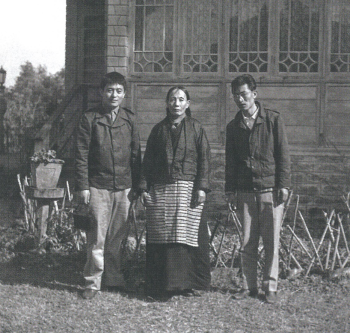Sangyum Kusho Tseten Yudron /桑嫞.辜秀.澤登.玉準/ 聽列諾布仁波切之母
Sangyum Kusho Tseten Yudron (‘Turquoise Lamp of Firm Life’) was the first wife of Dudjom Rinpoche. Together, they had seven children, four sons and three daughters: 敦珠法王的第一位佛母,育有七個小孩,七男三女:
- Semo Dechen Yudron (daughter), who stayed in Lhasa and then Lama Ling. 先待在拉薩,後來到喇嘛林。
- Thinley Norbu Rinpoche (son), who went to India, Bhutan and settled in the USA. 前往印度、不丹,定居於美國。
- Dola Tulku Jigme Chökyi Nyima Rinpoche (son), who stayed in Qinghai, China. 待在中國青海。
- Semo Pema Yudron (daughter).
- Phende Norbu Rinpoche (son), who settled in Nepal. 定居於尼泊爾。
- Se Dorje Palzang (son), who was killed during the Cultural Revolution. 文革時遭到殺害。
- Tsering Yangchen (daughter), who passed away in Tibet when she was young. 年輕時於西藏過世。
聽列諾布仁波切於《喜瑪拉雅一位人士的精采簡史》一書中表示:
家母的名字是瑪雍澤登玉準(拉,尊稱)。她出生在喜馬拉雅山脈西部靠近雅礱藏布江(意思:大供養河海)的地方,來自著名的貴族家庭「多卡蘇培米久」(意思:朝前堡壘家族分支)。在她於西藏的青年時期,貴族通常與貴族通婚,但她只對嫁給佛教老師感興趣。她對許多崇高者有著極大信心,包括佛陀、蓮花生大士、度母,以及她的根本上師秀瑟傑尊瑪洛千卻尼桑摩(1852-1953),後者為殊勝狂智瑜伽女瑪吉拉準(意思:拉契唯一母燈,1055-1149)的化現,而瑪吉拉準的上師是一位名叫帕當巴桑傑(意思:唯一神聖佛父,卒於1117年)的智慧聖者,他曾說:「一晚,我於心中低語三字,她就獲得了解脫」[...]
當我十三歲時,曾聽到有人說,他的一位老師對朋友悄聲講,他的父母已經分開了,但我並不清楚理解他的意思。當我十七歲到西藏中部探望父母時,我仍然習慣看到他們在一起,但當我們到達家父的房子時,卻找不到母親,因為他們擁有不同的家。有那麼一刻,我感覺彷彿失去了自己珍貴的心。不久,家母派人來找我,我與留在家中的兄弟姐妹一起去見她,從那時起,我們便在父母的房子之間來回穿梭。
家母經常講述關於偉大菩薩和聖者的精彩故事和悲傷歷史。她的本性無執且古怪,超脫而不可觸及。她總在禮拜、祈禱和供養。她特別喜歡用清水做供養,無論她住在哪裡,她向來會去提水、用水裝滿空罐,並到處灑水。下雨時,即使她還沒完全穿好衣服,也會跑到外面,舉杯對著天空裝水以便用來供養。她如此熱愛水,看起來像是瑪瑪姬(寶生佛佛母,水大種的清淨相)的化現。
她偏好蠟燭而非電燈,她的房子看起來像雞舍,因為地板上覆蓋著數千滴蠟油。秋天,人們有時會看到她爬上果樹,在水果落地前以清淨發心摘取水果來供養。她避開那些特別留下要照顧她的人,表示那會阻礙她的自由,而偏好由粗心的年輕人照顧,因為後者會讓她做她想做的事。她喜歡自己煮飯,並且當她用袖子和裙子把鍋子從爐檯上拿下來時,往往會燒到那些布料。當我們責備她說:「這不符合正確的世俗習慣」,或「這不符合正確的佛法習慣」時,她就回答:「正確的世俗習慣沒有意義,我怎能相應行事?正確的佛法習慣沒有實質,我怎能相應行事?」一般人通常認為家母瘋了並侮辱她,而許多崇高者則說她確實是空行母(智慧空行者)並讚美她。她一直由衷地愛著並讚美每個孩子,也為他們祈禱。她不了解如何教導我們在世俗上自立;她只想引導我們走向佛法。
According to Thinley Norbu Rinpoche[1]:
- My mother’s name is Mayum Tseten Yudron-la. She was born west of Himalayas near the Great Ocean River of Offering (Yarlung Tsangpo) and came from a renowned noble family named “Dokhar Surpe Migyu” (Family Branch of Front-Facing Fortress). During a youth in Tibet, it was the custom for aristocrats to marry aristocrats, but she was only interested in marrying a Buddhist teacher. She has great faith in many sublime beings including Buddha, Padmasambhava, Tara, and her root guru, Shuksep Jetsunma Lochen Chönyi Zangmo (1852-1953), who was an emanation of a sublime-crazy yogini named Machik Labdrön (Sole Mother Lamp of Lapchi, 1055-1149), whose teacher, a wisdom saint named Padampa Sangye––(Sole Holy Buddha Father, d. 1117) said, “One night I heart-whispered three words and she was liberated”[...]
- When I was thirteen years old, I heard one of his teachers whispering with his friends that his parents had separated, but I didn’t understand clearly what he meant. When I was seventeen years old and went to visit my parents in the center of Tibet, I still had the habit of seeing them together, but when we arrived at my father’s house, I couldn’t find my mother because they had separate homes. For a moment, I felt as if I had lost my precious heart. Soon my mother sent for me, and I went to see her with my brothers and sisters who were staying home, and from then on, we went back and forth between our parents’ houses.
- My mother often tells wonderful tales and sad histories of awesome bodhisattvas and saints. Her nature is unpossessive and eccentric, detached and untouchable. She is always worshiping, praying, and making offerings. She especially likes to make offerings with fresh water, and whenever she stays, she is always bringing water, filling empty pots with water, and scattering water everywhere. When it rains, even if she is half dressed, she runs outside, holding cups to the sky to collect water for offerings. She is so much in love with water, she seems like the emanation of Mamaki.
- She prefers candle to electricity, and her house looks like a chicken coop because the floor is covered with thousands of drops of wax. Sometimes in autumn, she can be seen climbing the fruit trees to pick fruits for offerings from her pure intention before they have dropped on the land. She avoids the people left to take care of her, saying that prevents her from being free, and prefers to be looked after by careless youngsters because they let her do what she wishes. She likes to cook by herself, and has often burned a cloth when she took the pots off the stove with her sleeves and skirt. When we scold her and say, “This is not according to correct worldly customs, “or “This is not according to correct Dharma custom”, she answers, “There is no meaning to correct worldly custom, so how can I act according to it? There is no substance to correct Dharma custom, so how can I act accordingly to it?” Many ordinary people think my mother is crazy and insult her, and many sublime beings say she is truly a dakini (wisdom sky-goer) and praise her. She always loves, praises, and prays for each of her children from her heart. She didn’t know how to teach us to support ourselves in a worldly way; she only tried to lead us to Dharma.
Internal Links
Notes
- ↑ Thinley Norbu, A Brief Fantasy History of an Himalayan (Shambhala, 2014), page 8 & 13.
